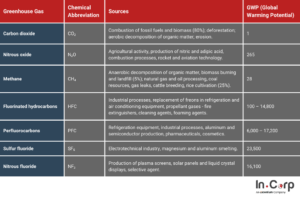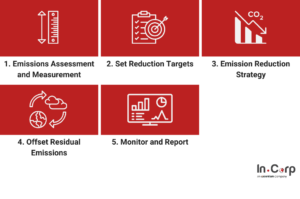As the global urgency to mitigate climate change intensifies, corporations face increasing pressure to measure, reduce, and offset their carbon footprints. This underscores the crucial role businesses play in the fight against climate change.
Businesses are a significant source of greenhouse gas (GHG) emissions, making corporate decarbonization strategies essential. A carbon reduction strategy can enhance companies’ brand reputation and drive sustainability.
We will explore an overview of decarbonization, carbon footprint calculation methods, and strategies for effective emission reductions to streamline your business’s decarbonization strategy.
What is a decarbonization strategy?
A decarbonization strategy is a structured plan businesses implement to reduce their greenhouse gas (GHG) emissions. It involves assessing emission sources, setting reduction targets, and transitioning to sustainable energy sources.
Companies like the Paris Agreement and the Science-Based Targets Initiative (SBTi) adopt decarbonization strategies to align with global climate commitments.
Key components of the plan include:
- GHG Emissions Assessment: Identifying and quantifying emission sources.
- Reduction Roadmaps: Setting short and long-term emission reduction goals.
- Operational and Technological Shifts: Implementing energy efficiency measures, renewable energy adoption, and process optimizations.
- Carbon Offsetting: Investing in projects that compensate for residual emissions.
Why should companies establish a decarbonization strategy?
Corporations must implement decarbonization strategies for several critical reasons:
Regulatory Compliance
Governments are introducing stricter emissions regulations, such as carbon pricing and reporting requirements. Companies must comply to avoid financial penalties and legal risks.
Cost Savings
Energy efficiency measures, process optimizations, and renewable energy investments can significantly reduce operational costs. By using renewables and improving efficiency, businesses can lower their expenses over time, providing a clear financial incentive for decarbonization.
Reputation & Stakeholder Expectations
Consumers, investors, and employees increasingly support sustainable businesses. Companies that reduce their carbon footprint can gain customer trust and brand loyalty.
Competitive Advantage
Eco-friendly businesses stand out in the market. Sustainability not only gives companies a competitive edge but also opens new opportunities for growth, making it a strategic business decision.
Risk Management
Climate risks like extreme weather and resource shortages can disrupt business. A decarbonization strategy helps mitigate these risks and ensures business resilience.
Read more: 7 ESG strategies for long-term business growth and impact
Corporate carbon footprint validation
A corporate carbon footprint measures a company’s total greenhouse gas (GHG) emissions. It includes direct emissions (from owned sources) and indirect emissions (from purchased energy and supply chains).
Companies can generate GHG emissions from various activities, categorized into three scopes:
Scope 1: Direct Emissions
These emissions come from company-owned or controlled sources, such as company vehicles and on-site fuel combustion.
Scope 2: Indirect Emissions from Energy
These are emissions from purchased electricity, heating, and cooling used in business operations.
Scope 3: Indirect Value Chain Emissions
This includes supplier emissions, product transportation, business travel, and employee commuting. Scope 3 is often the largest but most complex to track.
How to validate a corporate carbon footprint
Validating a corporate carbon footprint ensures that reported emissions are accurate, reliable, and aligned with global sustainability expectations. A structured validation process enhances transparency, regulatory compliance, and investor confidence.
1. Comprehensive emissions assessment
To establish an accurate footprint, all emission sources must be thoroughly evaluated. Identifying key emission drivers allows businesses to focus on the most impactful reduction strategies.
2. Following international standards
Validation must align with established frameworks such as the Greenhouse Gas Protocol (GHG Protocol) or ISO 14064 to ensure consistency and comparability. Following these standards enhances credibility and simplifies reporting for regulatory bodies, investors, and sustainability benchmarks.
3. Independent expert validation
Engaging external sustainability professionals for third-party verification strengthens the credibility of reported emissions data. Independent validation ensures consistency and compliance with reporting and builds trust among stakeholders like regulators, investors, and partners.
4. Implement continuous monitoring
Continuous monitoring and periodic reassessments help businesses track progress, adjust strategies, and stay aligned with sustainability targets. Substantial data collection and emission tracking support long-term carbon management improvements in corporate decisions.
Read more: Net Zero Strategies: Cutting Carbon Footprint for Business Growth
Step-by-step guide to calculate corporate carbon footprints
Accurately measuring a company’s carbon footprint is the first step in reducing emissions. Businesses can use a standard formula to calculate emissions and identify key areas for improvement.
What is the formula used to calculate carbon footprint?
The basic formula for calculating emissions is:
Carbon Footprint = ∑ (Activity Data × Emission Factor)
Where:
- Activity Data = Measured usage (e.g., fuel consumption, electricity usage, miles traveled).
- Emission Factor = The amount of CO₂ emitted per unit of activity (based on recognized databases like the EPA or GHG Protocol).
Five essential steps to develop a corporate decarbonization strategy
A well-structured decarbonization strategy helps businesses systematically reduce their carbon footprint. Here are five critical steps to create and implement an effective plan.
1. Assess And Measure Emissions
Before reducing emissions, companies must understand their carbon footprint, including:
- Identifying Scope 1, 2, and 3 emissions.
- Using a carbon footprint calculator for accurate measurements.
- Conducting a GHG inventory audit to verify data.
2. Set Clear Reduction Targets
After measuring emissions, companies should set realistic goals aligned with global standards, like:
- Science-Based Targets Initiative (SBTi): Ensuring targets support climate action.
- Net-Zero Commitments: Aiming for carbon neutrality by a specific year.
- Short- and Long-Term Goals: Companies can plan to reduce emissions by 30% by 2030 and achieve net-zero emissions by 2050.
3. Implement Emission Reduction Strategies
Companies can reduce emissions through various approaches:
- Energy Efficiency: Upgrading lighting, insulation, and equipment.
- Renewable Energy Adoption: Switching to solar, wind, or other renewables.
- Supply Chain Optimization: Partnering with sustainable suppliers.
- Sustainable Transportation: Encouraging electric fleets and remote work policies.
4. Offset Residual Emissions
Some emissions are unavoidable, but companies can balance them by:
- Investing in carbon offset projects like reforestation.
- Purchasing carbon credits to compensate for emissions.
- Supporting carbon capture technology to remove CO₂ from the atmosphere.
5. Monitor Progress and Report Transparently
Regular monitoring ensures accountability and continuous improvement with several initiatives, such as:
- Use ESG reporting frameworks like the Global Reporting Initiative (GRI).
- Track key performance indicators (KPIs) for emissions.
- Publish annual sustainability reports for stakeholders.
By following these essential steps, companies can ensure an effective decarbonization strategy, enforce a greener reputation, and foster long-term growth and sustainability.
Read more: Sustainable business models built on green infrastructure
How InCorp can help?
Reducing carbon emissions is crucial for businesses to remain competitive and sustainable. InCorp Indonesia (An Ascentium Company) provides comprehensive decarbonization solution and ESG Advisory services to simplify corporate carbon footprint calculations and decarbonization efforts, helping companies enhance efficiency and drive growth.
With our one-stop solution services, you can:
- Create effective decarbonization strategies tailored to your business.
- Ensure compliance with sustainability regulations and industry standards.
- Lower operational costs through energy efficiency and eco-friendly investments.
Boost your brand reputation with clear and transparent ESG reporting.
Contact us today to start building a greener, more resilient business for the future!
Get in touch with us.
What you'll get
A prompt response to your inquiry
Knowledge for doing business from local experts
Ongoing support for your business
Disclaimer
The information is provided by PT. Cekindo Business International (“InCorp Indonesia/ we”) for general purpose only and we make no representations or warranties of any kind.
We do not act as an authorized government or non-government provider for official documents and services, which is issued by the Government of the Republic of Indonesia or its appointed officials. We do not promote any official government document or services of the Government of the Republic of Indonesia, including but not limited to, business identifiers, health and welfare assistance programs and benefits, unclaimed tax rebate, electronic travel visa and authorization, passports in this website.





